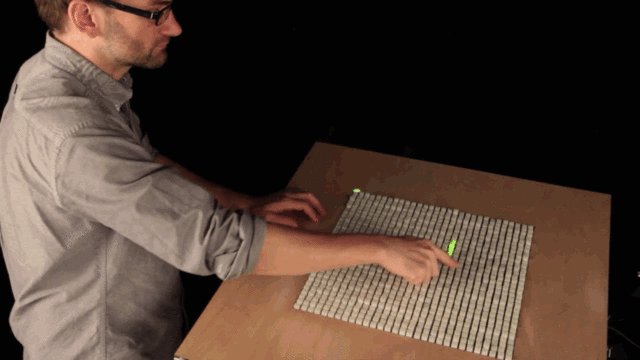MIT
Invents A Shapeshifting Display You Can Reach Through And Touch
THE TANGIBLE MEDIA GROUP AT MIT'S MEDIA LAB HAS UNVEILED A
FUTURISTIC DISPLAY MADE OF ATOMS, NOT PIXELS.
We live in an age of touch-screen interfaces, but what will
the UIs of
the future look like? Will they continue to be made up of ghostly pixels, or
will they be made of atoms that you can reach out and touch?
At the MIT Media
Lab, the Tangible
Media Groupbelieves the future of computing is
tactile. Unveiled today, the inFORM is
MIT's new scrying pool for imagining the interfaces of tomorrow. Almost like a
table of living clay, the inFORM is a surface that three-dimensionally changes
shape, allowing users to not only interact with digital content in meatspace,
but even hold hands with a person hundreds of miles away. And that's only the
beginning.
To put it in the simplest terms, the inFORM is a self-aware
computer monitor that doesn't just display light, but shape as well. Remotely,
two people Skyping could physically interact by playing catch, for example, or
manipulating an object together, or even slapping high five from across the
planet. Another use is to physically manipulate purely digital objects. A 3-D
model, for example, can be brought to life with the inFORM, and then
manipulated with your hands to adjust, tweak, or even radically transform the
digital blueprint.

But what really interests the Tangible Media Group is the
transformable UIs of the future. As the world increasingly embraces touch
screens, the pullable knobs, twisting dials, and pushable buttons that defined
the interfaces of the past have become digital ghosts. The tactile is gone and
the Tangible Media Group sees that as a huge problem.
"Right now, the things designers can create with
graphics are more powerful and flexible than in hardware," Leithinger
tells Co.Design. "The result is our gadgets have been consumed by the
screen and become indistinguishable black rectangles with barely any physical
controls. That's why BlackBerry is dying."

In other words, our devices have been designed to simulateaffordances—the
quality which allows an object to perform a function, such as a handle, a dial
or a wheel—but not actually have them. Follmer says that's not
the way it's supposed to be. "As humans, we have evolved to interact
physically with our environments, but in the 21st century, we're missing out on
all of this tactile sensation that is meant to guide us, limit us, and make us
feel more connected," he says. "In the transition to purely digital
interfaces, something profound has been lost."
The solution is programmable matter, and the inFORM is one
possible interpretation of an interface that can transform itself to physically
be whatever it needs to be. It's an interesting (and literal) analogue toskeuomorphism: while in the touch-screen age we have started
rejecting interfaces that ape the look of real world affordances as
"tacky" in favor of more pure digital UIs, the guys at the Tangible
Media Group believe that interface of the future won't be skeuomorphic. They'll
be supermorphic, growing the affordances they need on the fly.
Although the inFORM is primarily a sandbox for MIT to
experiment with the tactile interfaces to come, it would be wrong to dismiss
this project as mere spitballing. "We like to think of ourselves as
imagining the futures, plural," Follmer says. "The inFORM is a look
at one of them." But while the actual consumer implementation may very
well differ, but both Follmer and Leithinger agree that tangible interfaces are
coming.
"Ten years ago, we had people at Media Lab working on
gestural interactions, and now they're everywhere, from the Microsoft Kinect to
the Nintendo Wiimote," says Follmer. "Whatever it ends up looking
like, the UI of the future won't be made of just pixels, but time and form as
well. And that future is only five or ten years away. It's time for designers
to start thinking about what that means now."
For more information see link below:
http://www.fastcodesign.com/3021522/innovation-by-design/mit-invents-a-shapeshifting-display-you-can-reach-through-and-touch
For more information see link below:
http://www.fastcodesign.com/3021522/innovation-by-design/mit-invents-a-shapeshifting-display-you-can-reach-through-and-touch
No comments:
Post a Comment